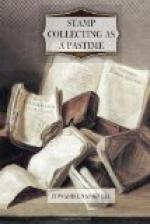27 paras, printed 6,000, sold 3,675. 54 " " 10,000 " 4,756. 81 " " 2,000 " 693. 108 " " 6,000 " 2,568.
All these stamps were printed by hand on coloured paper in sheets of thirty-two impressions in four rows of eight stamps. An unused copy of the 81 paras has fetched as much as L350.
[Illustration:]
United States, Millbury, 1847, 5 c.—In the United States the general adoption of postage stamps was preceded by what may be termed preliminary issues, of a more or less local character, and known as “Postmaster stamps.” These “Postmaster stamps” were issued by various country postmasters by way of experiment. The Providence stamp is the commonest example. One of the rarest is the 5 c. stamp, with a portrait of Washington, issued by the postmaster of Millbury, in Massachusetts, in 1847. This stamp is said to be worth about L300. There are others reputed to be equally rare. Among the local stamps issued by various unofficial carriers and express agencies, there are many of which very few copies are known, and as they are practically all held by enthusiastic collectors, and never come into the market, there are no data as to their current value.
[Illustration:]
Cape of Good Hope, 1861. Errors of Colour.—In making up the plate of a provisional issue of triangular stamps, pending the arrival of supplies from England, a stereo of the 1d. got inserted by mistake in the 4d. plate, and a 4d. in the 1d. plate. Consequently each sheet of the 1d. contained a 4d. printed in red, the colour of the 1d., instead of blue. And the sheets of the 4d., in like manner, each contained a 1d, which, when the 4d. was printed in its proper colour of blue, was also printed in blue instead of red, the proper colour. These errors are very scarce, especially in an unused condition. The 1d., blue, is the rarer of the two, and is worth about L70 used; it is not known unused.
[Illustration:]
Tuscany, 1860, 3 lire.—In the early days of stamp production high values, such as we are now accustomed to get from most countries, were very rarely issued. For nearly thirty years Great Britain was content with a shilling stamp as its highest value. In 1860 the Provisional Government of Tuscany issued a stamp of 3 lire, for which there seems to have been very little use. It represented but two shillings and sixpence of English money, but it is nevertheless one of the great rarities to-day, especially in an unused condition. Used copies are worth about L65, and unused about L120.
[Illustration:]
Transvaal, 1878. Error “Transvral.”—This error occurred once in each sheet of eighty of the 1d., red on blue, of the first British Occupation. It was evidently discovered before a second lot was required, as it does not recur in the next printing of 1d., red on orange. It is a very rare stamp. Used it is worth about L50, but unused it is one of the great rarities, and has changed hands at about L150.




